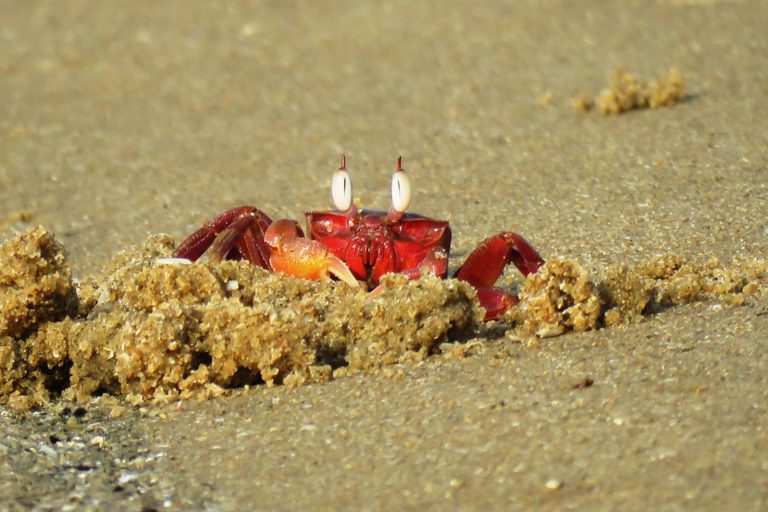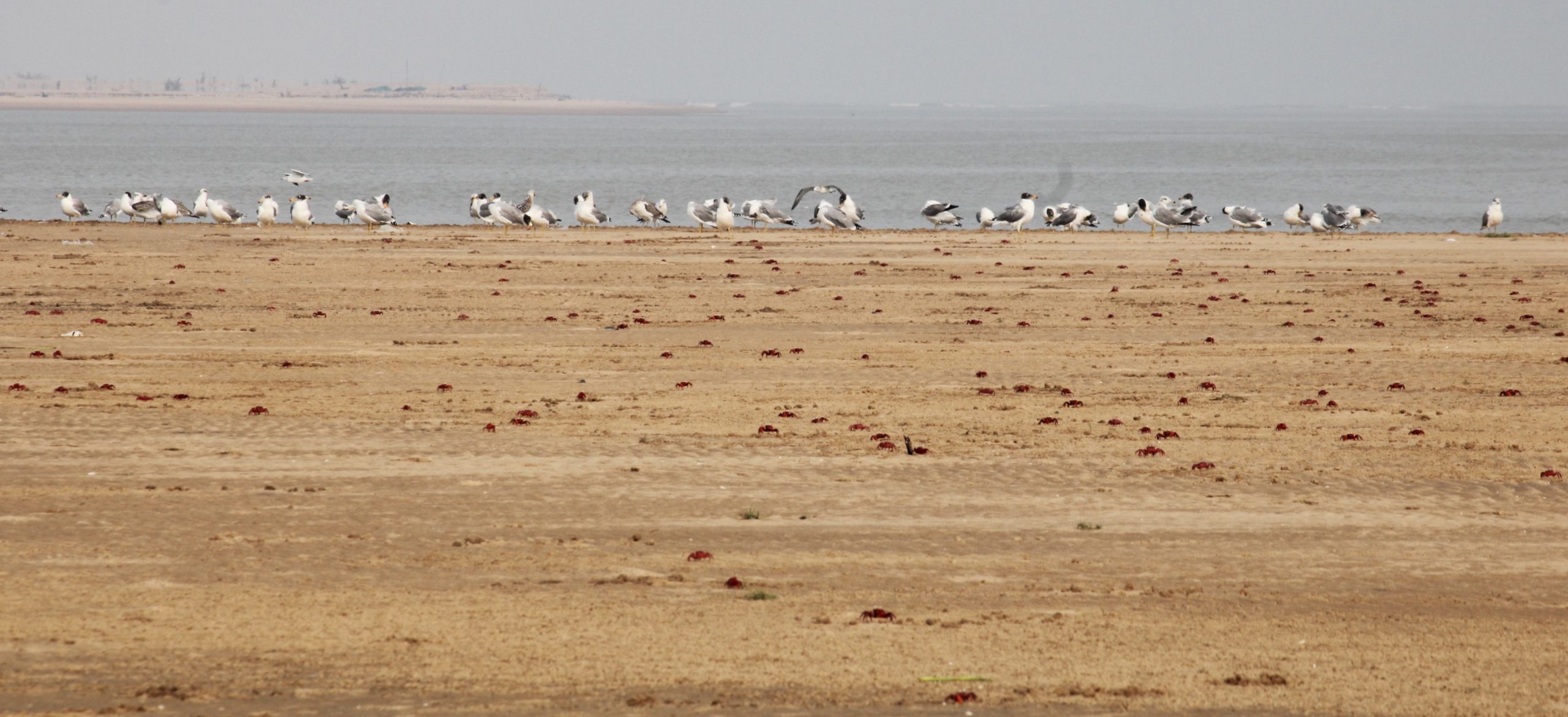- Talsari beach in Odisha and other beaches along the Balasore coast, draw many local tourists and wildlife enthusiasts hoping to get a glimpse of red ghost crabs that turn up every year in large numbers.
- The population of red ghost crabs here, however, has dwindled in recent years due to environmental pollution, habitat destruction and rising unsustainable tourism.
- There are new plans now to develop these beaches, that will bring in more tourists and boost the income of the local community, while also monitoring and protecting the red ghost crabs.
Talsari beach, located in the Balasore district of Odisha, is well-known among wildlife enthusiasts and local people in the state. Every year, it draws scores of people for a glimpse of the red ghost crabs (Ocypode macrocera) that turn up in such large numbers that the sand seems to turn red in colour. This species has added to the glory of the state’s beaches and now, the government aims to extend this ‘red carpet’ to more domestic and foreign tourists.
The Odisha Chief Minister Naveen Patnaik issued directions, at a high-level meeting in January this year, to develop the beaches of Talsari and Chandrabhaga, with world-class amenities. While tourism so far has been one of the factors impacting the crab population, with these latest plans, the authorities are aiming to balance beach development and income boost for the local community, with protection of the species.
Belonging to the Ocypodinae sub-family, the red ghost crabs have thick and elongated eyestalks, box-like bodies and different claw sizes (one claw being bigger than the other). They also stand out because of their bright red colour.
This species is semi-terrestrial and found on sandy shores in tropical and sub-tropical areas. The crabs are usually seen in larger numbers near estuaries and prefer beaches that were not frequented by humans. “In Odisha, they are often spotted at the Dagara Beach, Talasari Beach, Chandipur Beach and Balaramgadi Beach, along the Balasore coast. Their exact numbers are hard to tell. Geographic Information System (GIS) mapping, however, can help highlight hotspots of crab abundance and help us understand population dynamics of red ghost crabs,” says Sashi Paul, Principal Chief Conservator of Forests (PCCF), Wildlife.
Burrow matters
Adult crabs dig deep burrows. They remain in them during the hottest part of the day and throughout the coldest part of the winter to retain their body humidity. They are solitary feeders. Their feeding habit has been found to be both scavenging (feeding on dead animals) and predatory (hunting). They feed on snails, clams, turtle hatchlings, lizards, mole crabs, coquina and dead reptiles.
Every year, at the outset of the rainy season, they begin a mass migration to their seaside breeding grounds. There they build burrows that have a single opening towards the sea. The well-soaked sand provides the crabs with an environment that is thermally stable. Each burrow is occupied by a single crab.

Research on the species suggests that the burrow shape is directly related to tidal action and metabolic activities of the crab are strongly correlated with burrow microenvironment. They are adapted to the different sediment conditions, tidal fluctuations, varying salinity gradients, air and water temperatures and other environmental fluctuations. “Female crabs produce the eggs and develop them inside the burrows. These are then released into the sea between the last quarter and new moon,” says Viju Prada, a wildlife researcher.
Interestingly, if the weather delays the migration, the crabs put off spawning. “It occurs at an appropriate period to ensure maximum survival of the offspring. When a large number of crabs enter or exit the burrow at the same time, that section of the beach turns red. It makes for a breathtaking sight,” says Prada.
Same but different
There are other characteristics that set the red ghost crabs apart from other species of ghost crabs. Regular ghost crabs tend to be nocturnal feeders, but red ghost crabs are active both during the day and night. “Their main predators include shorebirds, reptiles and dogs. Red ghost crabs are fast runners and fend them off by darting into their burrows or flattening their bodies just under the surface of the sand,” says Paul. They also have a role to play in keeping the local ecology thriving. Research suggests that their digging behaviour enhances oxygenation in the ground soil and facilitates decomposition of organic materials and nutrient recycling.
Though it might seem like there are millions of them, their numbers have dwindled in recent times. “There has been a major impact on their population chiefly due to environmental pollution and pollutants originating in human activity,” says Paul. Locals also earn quick money by selling them to hotels in the area for a higher price as they are thought to be a delicacy.

Tourism too has had an impact on the natural habitat. “People walk on the beaches and damage the burrows. They leave behind plastic that harms the crabs. And their trash attracts dogs and other predators that feed on the crabs,” says Prada.
However, the local people in the region have been putting pressure on the authorities to develop the lesser-known areas to bring in more tourists which in turn will give a boost to their income. “Red ghost crabs visit the Devi river mouth on Astaranga beach in Puri. There are a number of tourism sites close by such as Pir Jahania. We want permanent motorboat facilities in the area so that the tourists can visit the river mouth and witness the rare sight. It would also bring in income for locals who don’t have other means to survive,” says Naveen Dutt, a local boat operator.
Balancing act
The development of a 2.4 km stretch of Talsari beach includes the construction of standard and budget hotels, a pavilion, kiosk, amphitheatres, restaurants and an arts and crafts plaza. The one kilometre stretch of Chandrabhaga includes developing water sports, a cycle track, wooden walking path, open theatre and gallery to see the sunrise. The state government has set a target to complete the projects by October 2021.
As the state develops beaches, the Forest Department is trying to balance tourism with conversation efforts. It has onshore camps at places between Debi Muhana and Chilika Muhana to monitor the red ghost crab marine species. Temporary check-posts have been set up to regulate the entry of vehicles into beaches and erect signboards at strategic points for public awareness to prevent any threat to the marine animals and their habitat.

In 2013, the state forest and environment department prepared an action plan to include this species in Schedule IV of the Wildlife Protection Act, 1972. But more needs to be done.
“The red ghost crab is not presently included in lists of threatened or endangered species of the International Union for Conservation of Nature (IUCN). We need to generate baseline information on present-day human exploitation of this species to boost conservation and protection plans in the state,” says Prada.
Read more: New tree-spide crab species with purple patches described from Kerala’s mangroves
Banner image: Female red ghost crab. Photo by Dr. Satyabrata Ghosh/Wikimedia Commons.
